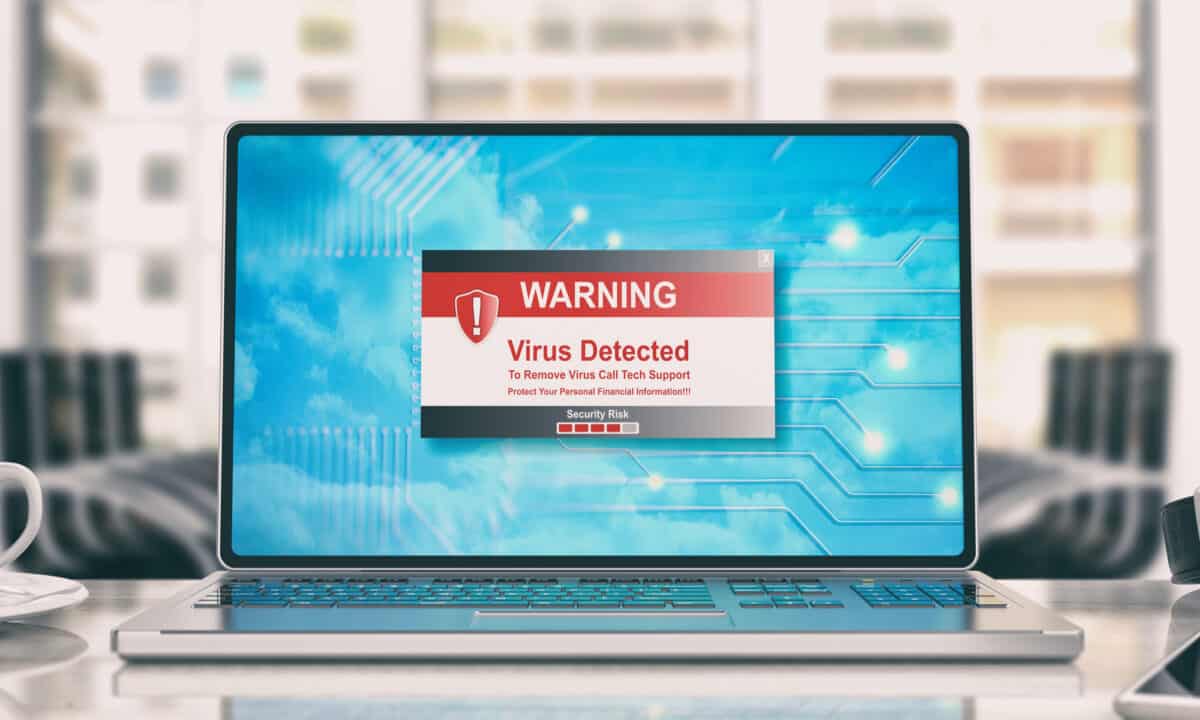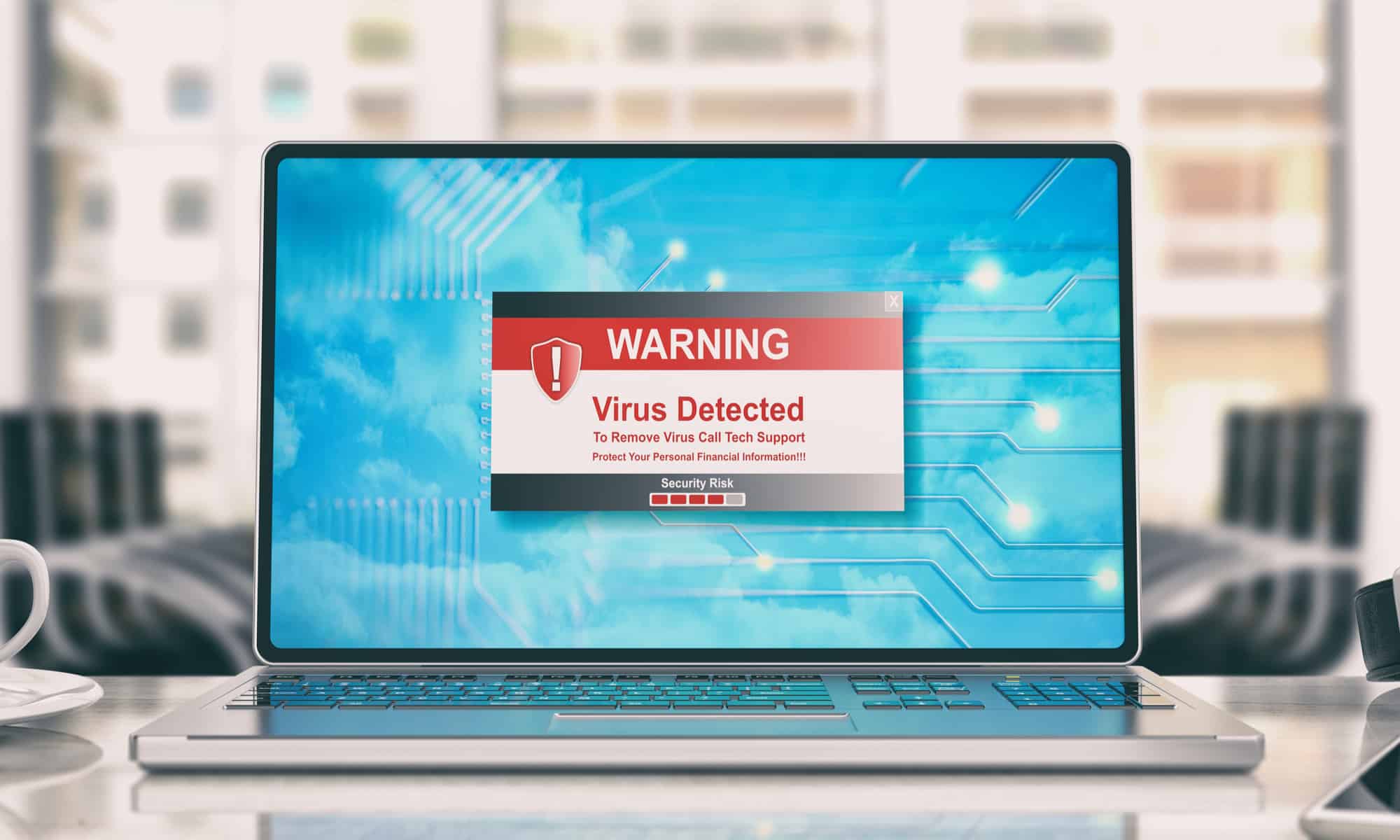Similar to the flu and other viral infections, a computer virus is designed to infect hosts, replicate itself, and spread between many hosts. They’re difficult to track to their source and can cause serious, unexpected damage. Explore a complete definition, types of computer viruses, and some of the worst viruses in history.
What Is a Computer Virus?

©rawf8/Shutterstock.com
A computer virus is a malicious program or code that is written to negatively affect a computer and how it operates. Some share files and data with other computers, while others erase documents, corrupt data, or target the operating system itself.
A virus is considered a type of malware, or malicious software. While similar, these terms have an important distinction. Malware is any malicious software that affects at least one device. A computer virus, however, is transferred between hosts much in the same way as a biological virus.
What Are the Different Types of Computer Viruses?
There are approximately 560,000 new malware pieces detected every day, with over one billion total malware programs, as of May 2022. Despite the incredible amount of viruses, many of them fit into one of these 11 categories. Review each type of file infector, Trojan horse, or another type before finding out what the damaging effects are and common ways to protect against these viruses.
Resident Virus
One of the most common types of viruses is a resident virus. This may have initially been sent to your device from an email or other source. It soon loads saves itself on your computer device and automatically infects files and software as you use them. A popular trick is for a resident virus to infect antivirus applications, causing it to replicate and spread with every antiviral check. This compromises the security and privacy of a device.
Boot Sector Virus
Boot sector viruses were one of the first types of computer viruses. While not as popular as it was in the 1990s, a boot sector virus can still be a dangerous form of malware. It affects the boot process, or startup process, and requires a total system reformat to remove. A boot sector virus used to be spread by floppy disks but is now more commonly attached to USB memory sticks or emails.
Macro Virus
Named after the macro language that programs are written in, a macro virus is spread through Microsoft Office and similar programs. The most common hosts for macro viruses include Microsoft Excel and Word, although they can also be spread by email. A macro virus increases in size and increases the size of files as it adds its code to the files.
Overwrite Virus
As the name implies, an overwrite virus simply writes over the original code in a file. This act erases the file, typically beyond recovery. They’re most commonly downloaded on the internet, so it’s essential to use antivirus software to check any file downloaded from the internet or an email to ensure privacy and security.
Trojan Horse
A Trojan horse is disguised to look like a standard file or software, though it hides malware. Once downloaded, it typically shares personal data with an outside source. A cyber-criminal can use a Trojan horse to take bank account information or blackmail a user with threats of sharing private information. This is another common form of cyber-attack.
Web Scripting Virus
A new form of malware attack, a web scripting virus, is a hacking strategy that deals with stolen cookies. Basically, it appears to be an authentic link on a popular site, like social media websites but takes personal information from cookies. The web scripting virus either attempts to damage data or overload a user with spam.
Browser Hijacker
One of the more annoying, though less damaging, viruses is a browser hijacker. Think of it as a false road sign or a dishonest salesman. If the hacking strategy is successful, a browser hijacker starts displaying irrelevant search engine results and greatly increases the number of pop-up adverts.
Spacefiller Virus
One of the more difficult viruses to detect and remove is a spacefiller virus. It identifies empty spaces in program code on your computer and adds its own code to fill in the spaces. Since it uses the existing code, it doesn’t change the size of the affected files. It may be rare and difficult to find but it can be highly destructive to essential system information.
Multipartite Virus
Fast, flexible, and increasing in popularity, these multi-part viruses are designed to attack files or the central boot sector of your computer. A multipartite virus is typically spread through .exe files and takes up a considerable amount of virtual memory. It’s a difficult type of computer virus to identify and prevent.
Polymorphic Virus
Another unique and difficult virus type is the polymorphic virus. It deletes data, shares files, and negatively affects an entire system after being downloaded or opened in an email attachment. This type of virus modifies itself in highly flexible ways, though antivirus software is attempting to catch up and identify attacks before your privacy is compromised.
Network Virus
Sharing files from computer to computer is easy with a strong network connection. The bad news is that a network virus can also be spread quickly throughout a network. This malware attack uses the trusted connections of an existing network to access data and damage files located throughout the network.
What Were the Worst Computer Viruses in History?
While some computer viruses are hacking pranks or slight inconveniences, others are capable of causing billions of dollars in damages across personal and commercial devices. Viruses aren’t the only form of malicious software but are the type most capable of infecting large numbers of devices. Some of the worst are known as worms, though there are also file infector viruses on the list. Here is a list of the worst computer viruses in history, from Mydoom to the ILOVEYOU virus, and the estimated cost of their damages:
- Mydoom ($38 billion): In 2004, this massive computer virus outbreak swept the world and was, at one point, responsible for a quarter of sent emails. It still exists, though only accounts for about 1% of phishing emails, and was a worm used to shut down a server or target website.
- Sobig ($30 billion): Another major worm attack, this time in 2003, came with many different versions and attacked users throughout Asia, Europe, and North America. It appeared to be legitimate software and disrupted many businesses, including Air Canada.
- Klez ($19.8 billion): This virus infected not only the host computer but other devices in the network in 2001. It was spread through fake emails and spoofed senders in an attempt to deactivate other viruses in 2001.
- ILOVEYOU ($15 billion): Also known as the LoveLetter, the ILOVEYOU virus was spread through an email including a text file. Once opened, the ILOVEYOU virus stole passwords and other data before sending itself to all of the user’s email contacts.
- WannaCry ($4 billion): While not as serious as the viruses of the early 2000s, the 2017 WannaCry virus affected government organizations, hospitals, and businesses by taking files hostage with ransom demands.
- Zeus ($3 billion): In 2007, Zeus caused an estimated 44% of all malware attacks on banking. It used a group of programs to take over devices and transfer money to hidden accounts. The Zeus virus was operated by a crime ring with over 100 members.
- Code Red ($2.4 billion): Starting in 2001, the Code Red virus is a worm that caused serious enough attacks that it required the U.S. White House to change its IP address. It showed “Hacked by Chinese!” across web pages from its operating base in a computer’s memory.
- Slammer ($1.2 billion): This worm randomly selected IP addresses and, once devices were infected, launched distributed denial of service (DDoS) attacks on internet hosts. At its peak, the Slammer virus took ATMs offline in many U.S. and Canadian bank locations.
- CryptoLocker ($665 million): From 2013 to its peak in 2017, CryptoLocker encrypted the files on as many as 250,000 devices before sending a ransom note and payment opportunity. It targeted businesses and cost an average of $133,000 per business.
- Sasser ($500 million): Despite its low infection rate, the Sasser worm still created a significant amount of damage and disruption. This worm was created by a 17-year-old computer science student, who was eventually caught and given a suspended sentence since he was a minor when he developed Sasser.
How Are Computer Viruses Spread?
Computer viruses are different from other forms of malware because they are spread from one device to another. Instead of simply damaging your computer or ransoming your data, these malicious attacks go on to affect other users in your network or email address book.
In the past, most viruses were spread through email attachments and infected floppy disks. Modern viruses are spread through shared documents, websites, links, and USB memory sticks.
What Are the Effects of a Computer Virus?
The effects of a computer virus vary depending on the type and its goal. Some damage your computer and erase your files while others steal your information and ruin your experience with pop-up windows and slow speeds. Here are some key signs that a computer may be infected by a virus:
- Slow computer operating speed
- Programs open or close themselves
- The device crashes or restarts unexpectedly
- A significant number of pop-up windows
- Emails are being sent from your account without your authorization
- Unexpected browser settings or homepage change
- Altered account login information
How Do You Stop a Computer Virus?
While there are a significant amount of dangerous computer viruses, there are also plenty of antivirus programs to choose from. Bitdefender, McAfee, Norton, and Microsoft are just a few popular companies that offer antivirus software. It’s important to make sure you’re downloading legitimate antivirus software. Some viruses disguise themselves as antivirus programs to avoid detection.
You should also be wary to open any files from unknown email addresses or any unusually named files. Even if you know the sender, consider verifying a file was personally sent before opening one. Don’t click on any unusual links sent through email addresses until you’ve verified they’re authentic.
Up Next…
Interested in reading more articles about viruses? Click on the links below:
- Can Macs Actually Get Viruses? Myth vs Reality: They were once believed impregnable to viruses? But just how true is it? Find out the truth about viruses and Macs.
- Resident Virus: How They Work, and How to Protect Yourself: It is capable of infiltrating your drive, and compromising any others attached to it. Find out all you need to know about it right here.
- Boot Sector Virus: How They Work, and How to Protect Yourself: Now something of a rarity, this virus hearkens back to the days when floppy discs were used to start computers. We reveal its source, its effects, and preventive measures against it.
The image featured at the top of this post is ©rawf8/Shutterstock.com.






